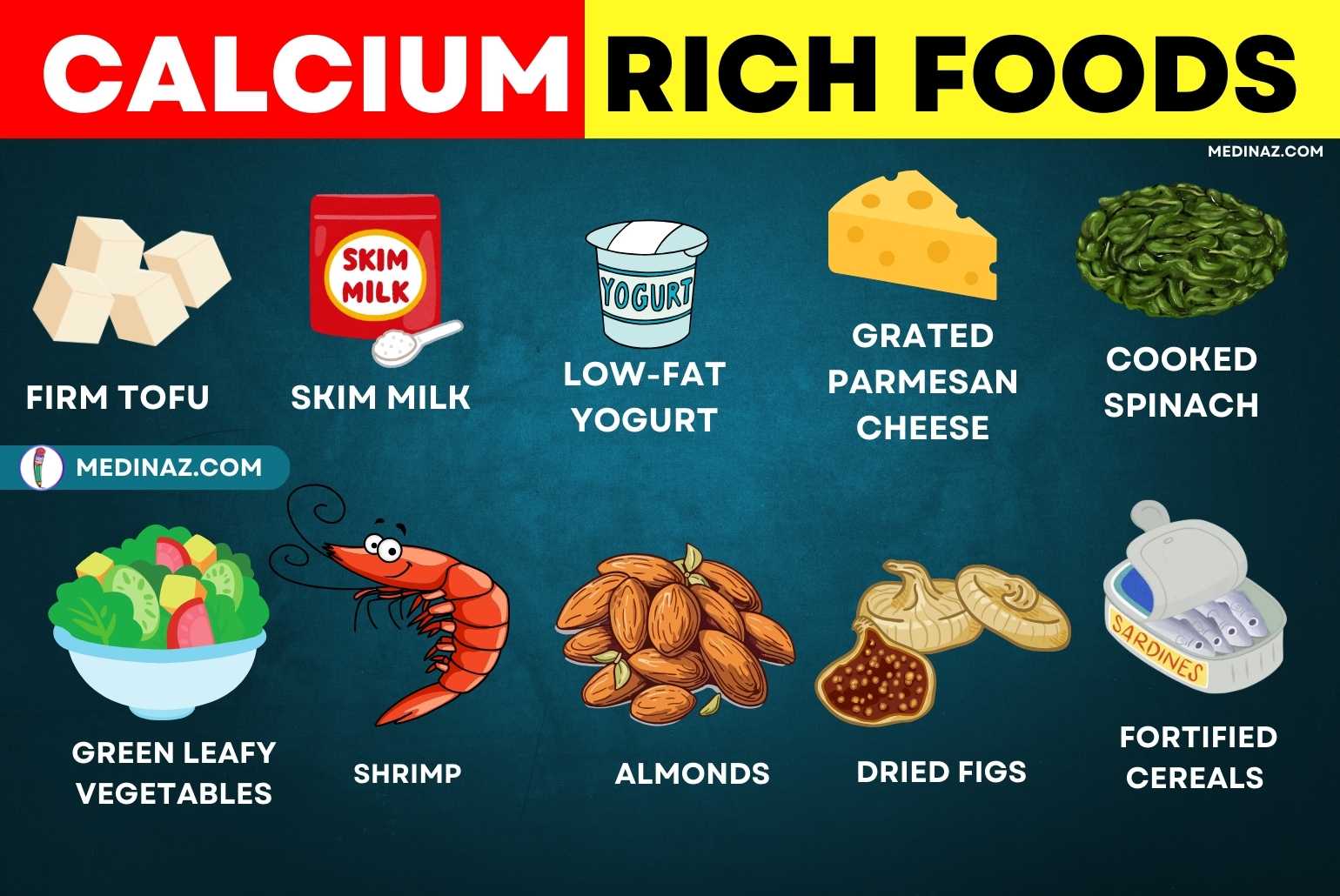Calcium-rich foods are essential for strong bones, teeth, and overall health. While dairy products are well-known for their calcium content, there are many other options, including seeds, nuts, leafy greens, and fortified beverages. In this blog, we’ll guide you through the best calcium-rich foods and how to incorporate them into your diet to meet your daily needs.
Here are the top 15 calcium-rich foods to help you meet your daily requirements and support overall health.
1. Cheese
Many cheeses are rich sources of calcium. Leading the pack is Parmesan cheese, offering 242 mg of calcium per ounce (28 grams), which equates to 19% of the daily value (DV) (ref).
On the other hand, softer cheeses typically provide less calcium. For example, an ounce (28 grams) of Brie supplies only 52 mg, or 4% of the DV (ref).
A notable advantage is that the calcium in dairy products is more easily absorbed by your body compared to plant sources.
Cheese is also a good source of protein. Cottage cheese, for instance, contains 23 grams of protein per cup (ref).
Additionally, aged, hard cheeses are naturally low in lactose, making them easier to digest for those with lactose intolerance .
Dairy products may offer extra health benefits. One review of 31 studies indicated that higher dairy consumption might be linked to a reduced risk of heart disease (ref).
Another review revealed that regular intake of milk and yogurt is associated with a lower risk of metabolic syndrome, a condition that increases the risk of heart disease, stroke, and type 2 diabetes (ref).
However, it’s important to remember that full-fat cheese can be high in saturated fat and calories. Additionally, some cheeses are high in sodium, which certain individuals may need to limit.
How to Choose the Best Cheese for Calcium:
- High-Calcium Varieties: Opt for hard cheeses like Parmesan, Gruyère, and cheddar, which are rich in calcium, typically providing 700-900 mg per 100 grams.
- Aged Cheeses: Choose aged cheeses, as they have higher calcium content due to nutrient concentration during aging.
- Fortified Options: Look for cheeses fortified with additional calcium for an extra boost.
- Check Labels: Compare calcium content per serving.
- Natural Ingredients: Avoid excessive additives.
- Lactose-Free Choices: If needed, choose lactose-free options.
- Portion Control: Balance with other calcium-rich foods.
2. Yogurt
Yogurt is an excellent calcium source.
Many varieties of yogurt are also packed with probiotics, beneficial bacteria that can boost immune function, improve heart health, and enhance nutrient absorption.
One cup (245 grams) of plain yogurt provides 23% of the daily value (DV) for calcium, along with significant amounts of phosphorus, potassium, and vitamins B2 and B12 (ref).
Low-fat yogurt can be even higher in calcium, offering 34% of the DV per cup (245 grams) (ref).
However, while Greek yogurt is a fantastic way to increase your protein intake, it contains less calcium than regular yogurt.
Besides offering a wide array of nutrients, some research indicates that regular yogurt consumption may be associated with a reduced risk of developing heart disease and type 2 diabetes.
How to Choose the Best Yogurt for Calcium:
- Check Calcium Content: Aim for yogurt that offers around 300 mg of calcium per 8-ounce serving (about 30% of the daily value).
- Type of Yogurt: Greek yogurt for protein, but verify calcium levels.
- Fortified Options: Look for yogurts fortified with additional calcium for a higher calcium intake.
- Natural Ingredients: Avoid added sugars and artificial flavors.
- Probiotics: Consider yogurt with live cultures for added digestive benefits, though this doesn’t impact calcium levels.
- Fat Content: Choose based on dietary needs.
- Portion Size: Balance yogurt intake with other calcium-rich foods to meet daily calcium needs.
3. Seeds
Seeds are small but mighty when it comes to nutrition, with many varieties, such as poppy, sesame, celery, and chia seeds, being particularly high in calcium.
For example, just 1 tablespoon (9 grams) of poppy seeds provides 127 mg of calcium, which is 10% of the recommended Daily Value (DV). (ref).
In addition to calcium, seeds are also a good source of protein and healthy fats. Chia seeds, in particular, are rich in plant-based omega-3 fatty acids (ref).
Sesame seeds offer 7% of the DV for calcium in a 1 tablespoon (9 grams) serving, along with other essential minerals like copper, iron, and manganese (ref).
How to Choose Seeds for Calcium:
- Calcium Content: Opt for seeds high in calcium, such as chia seeds (478-589 mg per 100 grams) and sesame seeds (975 mg per 100 grams). Poppy seeds are also excellent, with 1438 mg per 100 grams.
- Variety: Incorporate a range of seeds, like chia, sesame, poppy, and flaxseeds, to maximize calcium intake and benefit from their diverse nutrients.
- Preparation: Grind seeds like flaxseeds to enhance absorption, while chia seeds can be consumed whole.
- Quality: Choose organic or non-GMO for better quality and fewer pesticides.
- Storage: Store in airtight containers in a cool, dark place to maintain freshness and prevent rancidity.
- Combine: Add seeds to smoothies, salads, or baked goods, and pair them with other calcium-rich foods for a calcium boost.
4. Beans and Lentils
Beans and lentils are rich in fiber, protein, and essential micronutrients like iron, zinc, folate, magnesium, and potassium.
Certain types are also notable for their calcium content. For instance, winged beans provide 244 mg of calcium per cooked cup (172 grams), which is 19% of the daily value (DV). (ref).
White beans are another good source, with 1 cup (179 grams) of cooked white beans delivering 12% of the DV. Other beans and lentils contain smaller amounts, generally offering about 3-4% of the DV per cup (175 grams). (ref).
Interestingly, beans are often associated with the health benefits of plant-based diets. Research indicates that consuming beans may help lower LDL (bad) cholesterol and reduce the risk of developing type 2 diabetes.
How to Choose Beans and Lentils for Calcium:
- Calcium Content: Opt for beans and lentils with higher calcium levels. White beans offer about 160 mg, black-eyed peas 120 mg, and chickpeas 49 mg per 100 grams. Lentils are lower, with around 18 mg per 100 grams.
- Variety: Incorporate different types of beans and lentils into your diet to benefit from their unique nutritional profiles.
- Cooking Methods: Soak beans and lentils before cooking to reduce anti-nutrients like phytic acid, improving calcium absorption.
- Quality: Choose organic or non-GMO.
- Combine: Pair with leafy greens or fortified plant milks.
5. Almonds
Among all nuts, almonds stand out for their high calcium content. A single ounce (28 grams), which is roughly 23 almonds, provides 6% of the daily value (DV) (ref).
In addition to calcium, almonds offer 3.5 grams of fiber per ounce (28 grams), along with healthy fats and protein. They’re also a great source of magnesium, manganese, and vitamin E.
Incorporating nuts like almonds into your diet may contribute to lowering blood pressure, reducing body fat, and improving several other risk factors associated with metabolic disease (ref).
How to Choose the Best Almonds for Calcium:
- Calcium Content: Almonds provide about 269 mg per 100 grams , though they aren’t the highest among nuts.
- Freshness Over Variety: Focus on freshness and quality rather than specific almond varieties, as calcium differences are minor.
- Organic vs. Conventional: Both are good sources; organic may offer slightly more calcium.
- Whole vs. Almond Butter: Whole almonds provide more calcium.
- Serving Size: 1 ounce provides about 8% of the daily value.
- Combine with Other Sources: Pair almonds with other calcium-rich foods like leafy greens and fortified plant milks to meet your daily requirements.
6. Sardines and Canned Salmon
Sardines and canned salmon are rich in calcium, largely due to their edible bones.
A 3.75-ounce (92-gram) can of sardines provides 27% of the daily value (DV), while 3 ounces (85 grams) of canned salmon with bones offers 19% of the DV. (ref)
In addition to calcium, these oily fish are excellent sources of high-quality protein and omega-3 fatty acids, which support heart, brain, and skin health.
Although seafood can contain mercury, smaller fish like sardines have low levels. Moreover, both sardines and salmon are high in selenium, a mineral that helps prevent and reverse mercury toxicity.
How to Choose Sardines and Canned Salmon for Calcium:
- Calcium Content: Sardines provide about 325 mg of calcium per 100 grams, while canned salmon offers around 250 mg. Check labels for exact amounts.
- Type of Fish: Choose sardines for higher calcium due to their edible bones, and opt for wild-caught salmon for better nutritional quality.
- Packaging: Opt for BPA-free cans.
- Ingredients: Pick options with minimal additives, ideally packed in water, olive oil, or their own juices.
- Sustainability: Look for sustainably sourced fish, indicated by certifications like the MSC label.
- Serving Size: A typical serving is 3.5 ounces (100 grams). Regularly incorporate these into your diet.
7. Whey Protein
Whey is a protein derived from milk that has been extensively studied for its potential health benefits.
It’s not only an excellent source of protein but also packed with rapidly digested amino acids that aid in muscle growth and recovery. (ref)
Interestingly, research has linked diets rich in whey protein to increased weight loss and better blood sugar management.
Additionally, whey is exceptionally high in calcium — a 1.2-ounce (33-gram) scoop of whey protein powder isolate provides around 160 mg, or 12% of the daily value (DV). (ref)
How to Choose Whey Protein for Calcium:
- Calcium Content: Check the nutrition label for calcium levels, which typically range from 100-200 mg per scoop.
- Whey Type: Whey protein isolate has higher protein but slightly lower calcium than concentrate. Choose based on your dietary needs.
- Fortification: Look for whey protein fortified with extra calcium for an added boost.
- Minimal Additives: Opt for products with minimal sugars, artificial flavors, or preservatives.
- Quality Source: Opt for whey from grass-fed cows.
- Protein Purity: Higher purity whey powders offer more concentrated nutrients, including calcium.
- Combine with Other Sources: Pair whey protein with other calcium-rich foods like yogurt or cheese for optimal intake.
8. Rhubarb
Rhubarb is a good source of fiber, vitamin K, calcium, and smaller amounts of various other vitamins and minerals.
It also provides prebiotic fiber, which supports the growth of healthy gut bacteria.
However, like spinach, rhubarb is high in oxalates, which limit the absorption of calcium. A 2015 study revealed that your body absorbs only about 5% of the calcium in rhubarb. (ref)
Despite the limited absorption, rhubarb still contributes to your calcium intake, offering 105 mg of calcium per cup (122 grams) of raw rhubarb, or roughly 8% of the daily value (DV). (ref)
How to Choose Rhubarb for Calcium:
- Calcium Content: Rhubarb provides about 86 mg of calcium per 100 grams but contains oxalic acid, which can reduce calcium absorption.
- Freshness: Choose firm, bright-colored stalks for better flavor and nutrient retention.
- Organic: Opt for organic to avoid pesticides.
- Cooking Methods: Lightly cook rhubarb to reduce oxalic acid while preserving nutrients. Steaming or sautéing is ideal.
- Combine with Other Sources: Pair rhubarb with calcium-rich foods like dairy or fortified plant milks to boost calcium intake.
- Portion Size: Be mindful of portions to manage oxalic acid intake.
9. Leafy Greens
Leafy green vegetables are extremely nutritious, with many varieties, such as collard greens, spinach, and kale, offering a high calcium content.
For example, 1 cup (190 grams) of cooked collard greens provides 268 mg of calcium, which is about 21% of your daily requirement. (ref)
However, it’s important to note that some greens, like spinach, are high in oxalates—compounds that bind to calcium and hinder its absorption.
As a result, while spinach is rich in calcium, it’s not absorbed as efficiently as the calcium in other greens low in oxalates, such as kale and collard greens.
How to Choose the Best Leafy Greens for Calcium:
- Calcium Content: Opt for greens with high calcium levels, such as: Kale (93 mg), collard greens (268 mg), turnip greens (249 mg), spinach (245 mg) per cup.
- Oxalate Content: Choose lower-oxalate greens like kale, collards, and turnip greens to enhance calcium absorption. Avoid high-oxalate greens like spinach.
- Freshness: Select fresh, vibrant leaves without yellowing or bruising. Organic greens may offer slightly higher nutrient levels.
- Preparation: Lightly cook greens to increase calcium absorption, but avoid overcooking to preserve nutrients.
- Variety: Rotate different greens like kale, collards, turnip greens, bok choy, and arugula for a range of nutrients.
- Portion Sizes: Aim for 1-2 cups of cooked greens daily to boost calcium intake.
10. Fortified Foods
Fortified foods, such as cereals, can help meet daily calcium needs. Some cereals provide up to
Fortified foods, such as cereals, can significantly help you meet your daily calcium requirements.
Some cereals even offer up to 1,000 mg of calcium per serving, which is 100% of the daily value (DV) — and that’s before you add milk. (ref)
However, it’s important to note that your body cannot absorb all that calcium in one go, so it’s beneficial to spread your calcium intake throughout the day.
Additionally, flour and cornmeal are often fortified with calcium, which is why certain breads, tortillas, and crackers are high in this essential mineral. (ref)
How to Choose the Best Fortified Foods for Calcium
1. Type of Fortified Food:
- Dairy Products: Opt for fortified milk, yogurt, and cheese. These options provide well-absorbed calcium due to their lactose and protein content.
- Plant-Based Milks: Choose fortified almond, soy, or oat milks. Tip: Calcium carbonate is generally more bioavailable than calcium chloride in these products.
- Fortified Snacks: Look for fortified cereals and chocolates that can help meet your daily calcium needs.
2. Calcium Source and Bioavailability:
- Calcium Salts: Calcium carbonate offers 40% elemental calcium and is well-absorbed when taken with meals. If you have a higher gastric pH, calcium citrate might be a better option.
- Mineral Composition: Foods fortified with milk minerals may enhance calcium absorption, offering additional benefits.
3. Nutritional Profile:
- Vitamin D: Choose products that are fortified with both calcium and vitamin D, as this combination improves calcium absorption.
4. Ingredient Quality:
- Minimal Additives: Opt for fortified foods with minimal added sugars and preservatives. Focus on options derived from whole food sources.
5. Serving Size:
- Adequate Calcium: Aim for products that provide at least 200-300 mg of calcium per serving to ensure you’re getting a sufficient amount.
6. Taste and Texture:
- Sensory Quality: Select fortified foods that have an enjoyable taste and texture to encourage regular consumption.
11. Amaranth
Amaranth is a nutrient-dense pseudocereal.
It’s an excellent source of folate and is particularly rich in minerals like manganese, magnesium, phosphorus, and iron.
A single cup (246 grams) of cooked amaranth grain provides 116 mg of calcium, which is about 9% of the daily value (DV).
Amaranth leaves offer even more calcium, delivering 21% of the DV per cooked cup (132 grams), along with a substantial amount of vitamins A and C. (ref)
How to Choose the Best Amaranth Leaves for Calcium:
- Calcium Content: Amaranth leaves are rich in calcium, offering about 265 mg per 100 grams, making them one of the top calcium-rich greens.
- Oxalate Content: Although they contain moderate oxalates, the calcium in amaranth is still relatively well-absorbed.
- Freshness: Choose fresh, vibrant green leaves, avoiding any that are yellowing, wilting, or bruised. Organic options may offer higher nutrient levels.
- Preparation: Lightly cook the leaves to enhance calcium absorption, but avoid overcooking to preserve nutrients.
- Variety: Explore different varieties like red or green amaranth; all are excellent calcium sources.
- Portion Size: Aim for 1-2 cups of cooked leaves daily to boost calcium intake.
12. Fortified Drinks
Even if you don’t consume milk, you can still meet your calcium needs through various fortified nondairy beverages.
For instance, one cup (237 mL) of fortified soy milk provides 23% of the daily value (DV).
Additionally, with 6 grams of protein, soy milk is the nondairy alternative that most closely matches the nutritional profile of cow’s milk.
Other nut- and seed-based milks may be fortified with even higher levels of calcium.
Fortification isn’t limited to nondairy milks, though. For example, orange juice can also be fortified, offering up to 27% of the DV per cup (237 mL). (ref)
How to Choose the Best Fortified Drinks for Calcium:
- Calcium Content: Look for drinks that offer at least 300 mg of calcium per serving, similar to a glass of milk.
- Type of Drink: Choose from dairy, fortified plant-based milks, fortified juices, or functional beverages marketed for calcium content.
- Calcium Source: Opt for drinks using bioavailable forms like calcium carbonate or calcium citrate for better absorption.
- Additional Nutrients: Select drinks fortified with vitamin D to enhance calcium absorption.
- Ingredient Quality: Prefer drinks with minimal added sugars and preservatives, focusing on natural ingredients.
- Taste and Texture: Pick flavors and textures you enjoy to encourage regular consumption.
- Dietary Considerations: Ensure the drink fits your dietary needs, such as being lactose-free, gluten-free, or vegan.
13. Edamame and Tofu
Edamame beans are young soybeans, typically sold while still in their pods.
A cup (155 grams) of cooked edamame provides 8% of the daily value (DV) for calcium. It’s also rich in protein and offers your entire daily requirement of folate in just one serving (ref).
Calcium-set tofu is another excellent option, delivering more than 66% of the DV for calcium in just half a cup (126 grams) (ref).
How to Choose the Best Edamame and Tofu for Calcium
Choosing Edamame:
- Calcium Content: Opt for edamame with at least 10% DV of calcium per serving to maximize your intake.
- Shelled vs. In-Pod: Shelled edamame is preferable as it provides more calcium since you consume the entire bean.
- Fresh or Frozen: Go for fresh or frozen edamame, which retains more calcium compared to canned varieties. Organic options may offer slightly higher calcium levels due to nutrient-rich soil.
- Combine with Other Sources: Pair edamame with other calcium-rich foods like leafy greens and fortified plant milks for a more balanced calcium intake.
Choosing Tofu:
- Calcium-Fortified Tofu: Look for tofu labeled as calcium-fortified, particularly those made with calcium sulfate, which enhances calcium content.
- Firmness: Firmer tofu generally has higher calcium levels compared to softer varieties.
- Check Labels: Always compare the nutrition labels for calcium content to find the best option.
- Cooking: Cooking tofu at higher temperatures can help retain its calcium, making your dishes even more nutritious.
- Balanced Diet: Incorporate tofu into a balanced diet that includes other calcium-rich foods to meet your daily calcium needs effectively.
14. Figs
Dried figs are packed with antioxidants and fiber.
Among dried fruits, they stand out for their higher calcium content. A 1.4-ounce (40-gram) serving of dried figs offers 5% of the daily value (DV) for calcium. (ref)
In addition to calcium, figs are also a good source of potassium and vitamin K, two vital micronutrients that play a key role in maintaining bone health.
How to Choose Figs for Calcium:
- Calcium Content: ried figs are higher in calcium, offering about 162 mg per 100 grams, compared to 35 mg in fresh figs.
- Freshness: elect firm, blemish-free fresh figs or plump, moist dried figs. Avoid overly dry or hard figs.
- Organic Options: Choose organic figs for potentially higher nutrients and fewer pesticides.
- Sugar Content: Opt for dried figs without added sugars or preservatives.
- Storage: Pick figs in airtight packaging to maintain freshness and check expiration dates.
- Combine with Other Sources: Include figs in a diet with other calcium-rich foods like dairy or leafy greens.
- Portion Size: Limit to 2-4 dried figs per day to balance calcium intake with natural sugar content.
15. Milk
Milk is one of the most accessible and best sources of calcium.
A single cup (237 mL) of cow’s milk contains between 306 and 325 mg of calcium, depending on whether it’s whole or nonfat. The calcium found in dairy is also highly absorbable (ref).
In addition to calcium, milk is rich in protein, vitamin A, and vitamin D.
Goat’s milk is another excellent option, offering 327 mg of calcium per cup (237 mL) (ref).
How to Choose the Best Milk for Calcium:
- Calcium Content: Cow’s milk provides around 300 mg of calcium per cup. Choose whole, low-fat, or non-fat based on your preferences.
- Fortification: Some milk is fortified with extra calcium. Check the nutrition label for specifics.
- Bioavailability: Milk’s calcium is highly absorbable due to lactose and milk proteins, making it an excellent source.
- Organic vs. Conventional: Organic milk may have slightly more nutrients, but conventional milk is still a great calcium source.
- Lactose Intolerance: Opt for lactose-free milk or fortified plant-based options like almond or soy milk, though they may have less bioavailable calcium.
- Portion Size: One cup of milk provides about 30% of your daily calcium needs.
Conclusion:
Incorporating a variety of calcium-rich foods into your diet is essential for maintaining strong bones, teeth, and overall health. From dairy products like cheese and yogurt to plant-based options such as leafy greens, almonds, and fortified beverages, there are numerous calcium-rich foods to suit different dietary preferences and needs. By carefully selecting and preparing these foods, you can optimize your calcium intake and ensure you meet your daily nutritional requirements.
Remember to balance these sources with other essential nutrients, such as vitamin D, to enhance calcium absorption and maximize the benefits of calcium-rich foods. Whether you prefer traditional dairy or plant-based alternatives, including a wide range of calcium-rich foods in your diet will support your overall well-being and help you maintain strong, healthy bones for life.
A Visual Learning Platform





